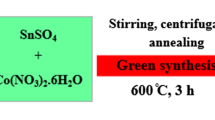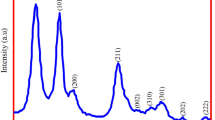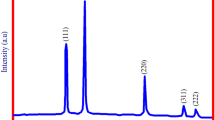Abstract
Different physical and chemical methods are available for the synthesis of potentially useful tin oxide nanoparticles; these available methods are tedious and produce environmental threat. The main objective of this study was to provide an environmentally benign method for the synthesis of tin oxide nanoparticles, evaluate its potential application in the treatment of waste water and also examine its biological applications. The present study focuses on one such green synthesis, where tin oxide nanoparticles are synthesized from leaf extract of Sambucus Canadensis plant. The leaf extract of Sambucus Canadensis plant was first time used in the synthesis of tin oxide nanoparticles. The synthesis of nanoparticles follows sol–gel technique and the isolated leaf extract of the selected medicinal plant act as stabilizing and capping agent in the synthesis of nanoparticles. The fabricated tin oxide nanoparticles were analyzed by some standard analytical tools like UV–visible spectroscopy, FTIR spectroscopy, X-ray diffraction, and scanning electron microscope. The synthesized nanoparticles underwent anti-bacterial examination by agar diffusion method against three different bacterial strains, namely E.coli, Pseudomonas spp. and Bacillus spp. The synthesized phytochemical coated nanoparticles showed maximum anti-bacterial activity against E. coli Gram negative strain at 60 mg/mL. The photocatalytic degradation proficiency of the synthesized nanoparticles was also examined for methyl red and Coomassie Brilliant Blue dye. The degradation efficiency of methyl red dye catalyzed by SnO2 NPs for exposure for 90 min was found to be 1.94% in sunlight, 0.88% in the dark and 0.27% under UV irradiation. Similarly, the degradation efficiency of Coomassie Brilliant Blue dye catalyzed by SnO2 NPs for 90 min of exposure was found to be 2.87% under direct sunlight, 0.11% in the dark and 2.87% in the UV light.
Graphical abstract











Similar content being viewed by others
Data availability
The authors confirm that the data of the findings of the present study are available in the article and the raw data of the present study are available from the corresponding author on reasonable request.
References
Thakur BK, Kumar A (2019) Green synthesis of TiO2 nanoparticles using Azadirachataindica leaf extract and evaluation of their antibacterial activity. S Afr J Bot 124:223–227
Jeevanandam J, Barhoum A, Chan YS, Dufresne A, Danquah MK (2018) Review on nanoparticles and nanostructured materials: history, sources, toxicity and regulations. Beilstein J Nanotechnol 9(1):1050–1074
Ahmad W, Kamboj A, Banerjee I, Jaiswal KK (2022) Pomegranate peels mediated synthesis of calcium oxide (CaO) nanoparticles, characterization, and antimicrobial applications. Inorg Nano Metal Chem. https://doi.org/10.1080/24701556.2021.2025080
Kaur H, Kaur S, Sing J, RawatMand Kumar S (2019) Expanding horizon: green synthesis of TiO2 nanoparticles using Carica papaya leaves for photocatalysis application. Mater Res Express. https://doi.org/10.1088/2053-1591/ab2ec5
Naushad M (2014) Surfactant assisted nano-composite cation exchanger: development, characterization and applications for the removal of toxic Pb2+ from aqueous medium. Chem Eng J 235:100–108
Subair R, Tripathi BP, Formanek P, Simon F, Uhlmann P, Stamm M (2016) Polydopamine modified membranes with in situ synthesized gold nanoparticles for catalytic and environmental applications. Chem Eng J 297:358–369
Kamal T, Khan SB, Asiri AM (2016) Synthesis of zero-valent Cu nanoparticles in the chitosan coating layer on cellulose microfibers: evaluation of azo dyes catalytic reduction. Cellulose 23:1911–1923
Shukla S, Chaudhary S, Umar A, Chaudhary GR, Kansal SK, Mehta SK (2016) Surfactant functionalized tungsten oxide nanoparticles with enhanced photocatalytic activity. Chem Eng J 288:423–431
Ahmad W, Jaiswal KK, Soni S (2020) Green synthesis of titanium dioxide (TiO2) nanoparticles by using Menthaarvensis leaves extract and its antimicrobial properties. Inorg Nano Metal Chem 50:1023–1038. https://doi.org/10.1080/24701556.2020.1732419
Sharma V (2019) Green synthesis of silver nanoparticles from medicinal plants and evaluation of their antiviral potential against chikungunya virus. Appl Microbiol Biotechnol 103:881–891
Aziz SB, Rasheed MA, Saeed SR, Abdullah OG (2017) Synthesis and characterization of CdS nanoparticles grown in a polymer solution using in-situ chemical reduction technique. Int J Electrochem Sci 12:3263–3274
Cruz Terrazas E, Lázaro RA, González MM, Luque PA, Castillo SJ, Carrillo-Castillo A (2015) A simple method for the synthesis of CdS nanoparticles using a novel surfactant. Chalcogenide Lett 12(4):147–153
Martínez-Alonso C, Cortina-Marrero HJ, Coria-Monroy CS, Arenas MC, Nicho ME, Hu H (2015) Solution synthesized CdS nanoparticles for hybrid solar cell applications. J Mater Sci Mater Electron 26(8):5539–5545
Al-Rawi UA, Sher F, Hazafa A, Rasheed T, Al-Shara NK, Lima EC, Shanshool J (2020) Catalytic activity of Pt loaded zeolites for hydroisomerization of n-hexane using supercritical CO2, nd. Eng Chem Res 59(51):22092–22106
Singh J, RawatM KaurHand (2018) A novel green approach for the synthesis of tungsten oxide nanorods and its efficient potential towards photocatalytic degradation of reactive green 19 dye. J Mater Sci Mater Electron 29:13715–13722
Singh J, Dutta T, Kim K-H, Rawat M, Samddar P, Kumar P (2018) Green synthesis of metals and their oxide nanoparticles: applications for environmental remediation. J Nanobiotechnol 16:84
Bhosale TT, Shinde HM, Gavade NL, Babar SB, Gawade VV, Sabale SR, Kamble RJ, Shirke BS, Garadkar KM (2018) Biosynthesis of SnO2 nanoparticles by aqueous leaf extract of calotropis gigantea for photocatalytic applications. J Mater Sci Mater Electron 29:6826–6834
Bhavana S, Gubbiveeranna V, Kusuma CG, Ravikumar H, Sumachirayu CK, Nagabhushana H, Nagaraju S (2019) Facile green synthesis of SnO2 NPs Using Vitex altissima (L.) leaves extracts: characterization and evaluation of antibacterial and anticancer properties. J Clust Sci. https://doi.org/10.1007/s10876-019-01496-w
Nehru LC, Sanjeeviraja C (2014) Rapid synthesis of nanocrystalline SnO2 by a microwave-assisted combustion method. J Adv Ceram 3:171–176
Ahmad W, Pandey A, Rajput V, Kumar V, Verma M, Kim H (2021) Plant extract mediated cost-effective tin oxide nanoparticles: a review on synthesis, properties, and potential applications. Curr Res Green Sustain Chem 4:100211
Singh J, Kaur H, Kukkar D, Mukamia VK, Kumar S, Rawat M (2019) Green synthesis of SnO2 NPs for solar light induced photocatalytic applications. Mater Res Express 6:11. https://doi.org/10.1088/2053-1591/ab4412
Fu L, Zheng Y, Ren Q, Wang A, Deng B (2015) Green biosynthesis of SnO2 nanoparticles by plectranthus amboinicus leaf extract their photocatalytic activity toward rhodamine B degradation. J Ovonic Res 11(1):21–26
Kumar M, Mehta A, Mishra A, Singh J, Rawat M, Basu S (2018) Biosynthesis of tin oxide nanoparticles using Psidium Guajava leave extract for photocatalytic dye degradation under sunlight. Mater Lett 215:121–124
Haritha E, Roopan SM, Madhavi G, Elango G, Al-Dhabi NA, Arasu MV (2016) Green chemical approach towards the synthesis of SnO2 NPs in argument with photocatalytic degradation of diazo dye and its kinetic studies. J Photochem Photobiol B Biol 162:441–447. https://doi.org/10.1016/j.jphotobiol.2016.07.010
Nathan MGT, Myvizhi P (2018) Green synthesis and characterization of tin oxide nanoparticles using plant extract. Int J Pure Appl Math 119(12):6439–6448
Suresh KC, Surendhiran S, Kumar M, Ranjth KE, Khadar YAS, Balamurugan A (2020) Green synthesis of SnO2 nanoparticles using Delonix elata leaf extract: evaluation of its structural, optical, morphological and photocatalytic properties. SN Appl Sci 2(10):1–13. https://doi.org/10.1007/s42452-020-03534-z
Tundis R, Ursino C, Bonesi M, Loizzo MR, Sicari V, Pellicanò T, Manfredi IL, Figoli A, Cassano A (2019) Flower and leaf extracts of Sambucusnigra L.: application of membrane processes to obtain fractions with antioxidant and antityrosinase properties. Membranes (Basel) 9(10):127. https://doi.org/10.3390/membranes9100127
Elango G, Kumaran SM, Kumar SS, Muthuraja S, Roopan SM (2015) Green synthesis of SnO2 nanoparticles and its photocatalytic activity of phenolsulfonphthalein dye. Spectrochim Acta Mol Biomol Spectrosc 145:176–180. https://doi.org/10.1016/j.saa.2015.03.033
Altaf F, Niazi MBK, Jahan Z et al (2021) Synthesis and characterization of PVA/starch hydrogel membranes incorporating essential oils aimed to be used in wound dressing applications. J Polym Environ 29:156–174. https://doi.org/10.1007/s10924-020-01866-w
Ahmad W, Singh S, Kumar S (2017) Phytochemical screening and antimicrobial study of Euphorbia hirta extracts. J Med Plants Stud 5(2):183–186
Naushad M, Alqadami AA, AlOthman ZA, Alsohaimi IH, Algamdi MS, Aldawsari AM (2019) Adsorption kinetics, isotherm and reusability studies for the removal of cationic dye from aqueous medium using arginine modified activated carbon. J Mol Liq 293:111442. https://doi.org/10.1016/j.molliq.2019.111442
Singh J, Kaur H, Kukkar D, Mukamia VK, Kumar S, Rawat M (2019) Green synthesis of SnO2 NPs for solar light induced photocatalytic applications. Mater Res Express 6:115007. https://doi.org/10.1088/2053-1591/ab4412
Fatimah I, Purwiandono G, Jauhari MH, Putri Maharani AAA, Sagadevan S, -Chun OhW, Doong RD (2022) Synthesis and control of the morphology of SnO2 nanoparticles via various concentrations of Tinospora cordifolia stem extract and reduction methods. Arab J Chem 15:103738
Elango G, Kumaran SM, Kumar SS, Muthuraja S, Roopan SM (2015) Green synthesis of SnO2 nanoparticles and its photocatalytic activity of phenolsulfonphthalein dye. Spectrochim Acta-Part A Mol Biomol Spectrosc 145:176–180
Tatsuda N, Nakamura T, Yamamoto D, Yamazaki T, Shimada T, YanoK InoueHand (2009) Synthesis of highly monodispersed mesoporous tin oxide spheres. Chem Mater 21:5252–5257
Haq S, Rehman W, Waseem M, Shah A, Khan AR, Rehman MU, Ahmad P, Khan B, Ali G (2020) Green synthesis and characterization of tin dioxide nanoparticles for photocatalytic and antimicrobial studies. Mater Res Express 7:025012
Acknowledgements
The authors extend their appreciation to the Researchers Supporting Project number (RSP2023R380) , King Saud University, Riyadh, Saudi Arabia.
Author information
Authors and Affiliations
Corresponding author
Ethics declarations
Conflict of interest
The authors declare that there is no any kind of competing interest in this work.
Additional information
Publisher's Note
Springer Nature remains neutral with regard to jurisdictional claims in published maps and institutional affiliations.
Rights and permissions
Springer Nature or its licensor (e.g. a society or other partner) holds exclusive rights to this article under a publishing agreement with the author(s) or other rightsholder(s); author self-archiving of the accepted manuscript version of this article is solely governed by the terms of such publishing agreement and applicable law.
About this article
Cite this article
Ahmad, W., Pandey, A., Ahmed, S. et al. Sambucus Canadensis leaf extract mediated synthesis and analysis of antibacterial and photocatalytic degradation property of stannous oxide nanoparticles. Nanotechnol. Environ. Eng. 8, 707–716 (2023). https://doi.org/10.1007/s41204-023-00317-w
Received:
Accepted:
Published:
Issue Date:
DOI: https://doi.org/10.1007/s41204-023-00317-w




